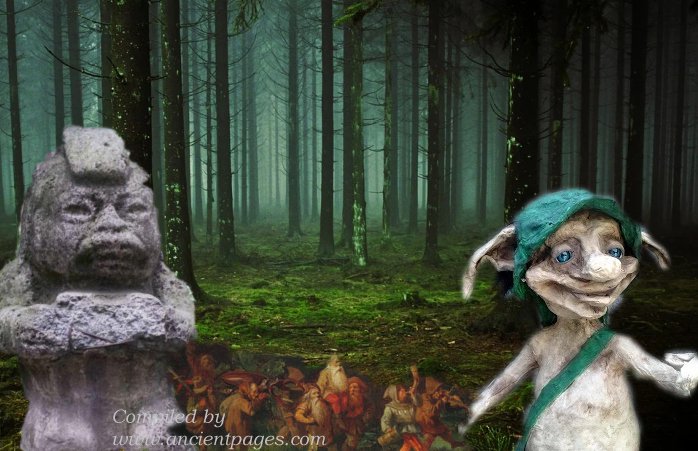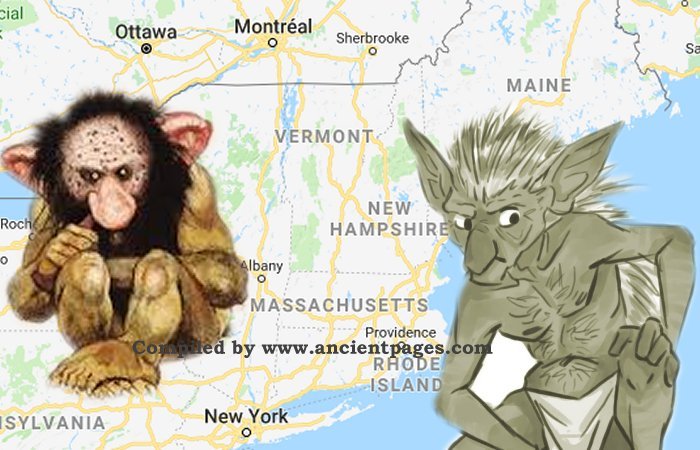Chaneques: Mischievous Legendary Tricksters In Mexican Folklore
A. Sutherland - AncientPages.com - Mysterious, magical individuals called 'chaneques' are famous in Mexican folklore; however, they also have a lot in common with the Pukwudgies, only knee-high or smaller, grey-faced forest people with large ears, as described in Algonquian folklore.
They are also similar in their behavior to Alux, a little trickster in Mayan folklore responsible for 'bad things and yet protects the field at night, summons rain, and helps grow the corn and bring wealth and good fortune.
In some contemporary legends, the chaneques (from Nahuatl, "those who live in dangerous places" or "owners of the house") are described as children with faces from elderly men or women. Otherwise, they are no more than one meter tall, have feet in reverse, a deformed body, sometimes lack a left ear, and laugh like a child. In other legends, they have huge heads and chocolate-colored skin.
White And Black Chaneques And Isolated Places
Tradition has it that the chaneques inhabit deep forests, mountains, abandoned ruins, springs, wildernesses, and ditches and belong in the underworld. Therefore, such places were traditionally avoided, and the spirits were associated with the evil powers. Who or what are the chaneques?
Are they dwarves with children's voices and faces? No one knows for sure. In the beliefs of ancient people, the chaneques are friendly and play pranks like mischievous children usually do by shaking hammocks, scaring animals or adults, throwing stones or dishes in the kitchen, hiding objects in the houses, and more.
Despite their playful nature, they are not so bad. Sometimes, they live in crops or under the same roof as people as long as these troublesome spirits do not take people's money, jewelry, or important papers or keys.
The chaneques remind us of the magical little forest people known as Pukwudgies. It's always advisable to be aware of their presence without disturbing them because many chaneques prefer to keep their distance.
Depending on local beliefs, there are good and bad individuals among these spirits. The good ones were similar to the elves, traced back to Norse, Celtic, and Germanic myths and legends, describing them as young, white, pleasant-looking, and bringing luck with them. On the other hand, the black ones had ugly deformities and brought darkness and diseases to the people.
One of the central beliefs related to the chaneques is that they pretend to be children who intentionally attract people to their world. They can even scare people to death; in that case, the soul leaves the body immediately captured by the chaneques who lock it up underground.
Tradition says that if the victim does not manage to recover his soul through a specific ritual, he falls ill and dies within a short time.
Chaneque Spirits In Ancient Catholic Beliefs And Contemporary Legends
In the Catholic beliefs of the Mexican people, the chaneques are the souls of the children who died without Christian baptism and probably originated from pre-colonial times. They are little demons who prey on people wandering alone in the forest or impenetrable jungles of Mexico.
Confusing people, they express their hostility to make them lost and prey on them at night, even eat them.
They can make people lose three to seven days, so they cannot recall anything that happened to them. Then, the victims realize they have been kidnapped by the malicious chaneques and taken to their afterlife, which is only accessed through a dry trunk of the ceiba tree, a sacred tree of most civilizations of Mesoamerica, including Mixtec, Aztec, and Maya. Long ago, the people believed that the ceiba grows deep into the underworld.
Even today, there are many testimonies of people who disappeared in the deep forests of central and southern Mexico.
Written by – A. Sutherland - AncientPages.com Senior Staff Write
Updated on February 8, 2024
Copyright © AncientPages.com All rights reserved. This material may not be published, broadcast, rewritten or redistributed in whole or part without the express written permission of AncientPages.com
More From Ancient Pages
-
 Nazar Amulet – Blue Color Wards Off The Evil Eye According To Ancient Belief
Ancient Symbols | Mar 13, 2018
Nazar Amulet – Blue Color Wards Off The Evil Eye According To Ancient Belief
Ancient Symbols | Mar 13, 2018 -
 Medieval Sword Found In The Sea Off The Carmel Coast Was Probably Used In Combat 800 Years Ago
News | Aug 4, 2023
Medieval Sword Found In The Sea Off The Carmel Coast Was Probably Used In Combat 800 Years Ago
News | Aug 4, 2023 -
 Mystery Of The Bizarre Dark Figure Vanishing Into Thin Air Seen By Hotel Guests And Staff
Featured Stories | Mar 15, 2019
Mystery Of The Bizarre Dark Figure Vanishing Into Thin Air Seen By Hotel Guests And Staff
Featured Stories | Mar 15, 2019 -
 On This Day In History: American Astronomer Edwin Hubble Announced Existence Of Other Galaxies – On Dec 30, 1924
News | Dec 30, 2016
On This Day In History: American Astronomer Edwin Hubble Announced Existence Of Other Galaxies – On Dec 30, 1924
News | Dec 30, 2016 -
 Our Lives Have Always Been Manipulated By Money – Part 2
Featured Stories | Jun 4, 2022
Our Lives Have Always Been Manipulated By Money – Part 2
Featured Stories | Jun 4, 2022 -
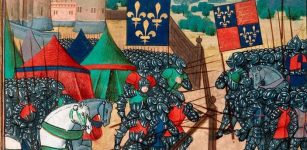 On This Day In History: Battle of Castillon Ended ‘Hundred Years’ War – On July 17, 1453
News | Jul 17, 2016
On This Day In History: Battle of Castillon Ended ‘Hundred Years’ War – On July 17, 1453
News | Jul 17, 2016 -
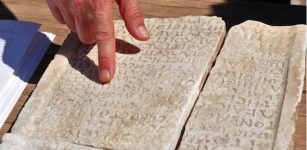 Mysterious 1,800-Year-Old Roman Marble Inscription Found In The Ancient City Of Aigai Deciphered
Archaeology | Oct 5, 2022
Mysterious 1,800-Year-Old Roman Marble Inscription Found In The Ancient City Of Aigai Deciphered
Archaeology | Oct 5, 2022 -
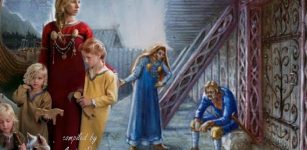 Mother, Father, Child, Marriage And Divorce In Viking Society
Ancient History Facts | Apr 27, 2020
Mother, Father, Child, Marriage And Divorce In Viking Society
Ancient History Facts | Apr 27, 2020 -
 Kobold: Mythological Spirit Of Underground: Guardian Of Miners And Earth’s Treasures
Featured Stories | Jun 13, 2016
Kobold: Mythological Spirit Of Underground: Guardian Of Miners And Earth’s Treasures
Featured Stories | Jun 13, 2016 -
 Never-Before-Seen Structures Of King Herod’s Magnificent Palace Herodium Unveiled
Archaeology | Dec 11, 2020
Never-Before-Seen Structures Of King Herod’s Magnificent Palace Herodium Unveiled
Archaeology | Dec 11, 2020 -
 Nicholas Roerich’s Search For Shambhala And Wish To Fulfill The Mysterious Buddhist Prophecy
Featured Stories | Nov 4, 2016
Nicholas Roerich’s Search For Shambhala And Wish To Fulfill The Mysterious Buddhist Prophecy
Featured Stories | Nov 4, 2016 -
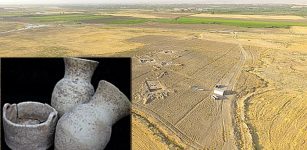 Mesopotamian People Liked To Drink Beer Using Variety Of Drinking Vessels
Archaeology | Jun 28, 2018
Mesopotamian People Liked To Drink Beer Using Variety Of Drinking Vessels
Archaeology | Jun 28, 2018 -
 Why Has The Leaning Tower Of Pisa Survived Strong Earthquakes Since The Middle Ages?
Archaeology | May 10, 2018
Why Has The Leaning Tower Of Pisa Survived Strong Earthquakes Since The Middle Ages?
Archaeology | May 10, 2018 -
 Catherine Of Alexandria Courageously Confronted 50 Pagan Philosophers And Was Sentenced To Death
Featured Stories | Oct 15, 2018
Catherine Of Alexandria Courageously Confronted 50 Pagan Philosophers And Was Sentenced To Death
Featured Stories | Oct 15, 2018 -
 Ancient Cave Church Complex In Basarabi, Romania
Civilizations | Dec 11, 2018
Ancient Cave Church Complex In Basarabi, Romania
Civilizations | Dec 11, 2018 -
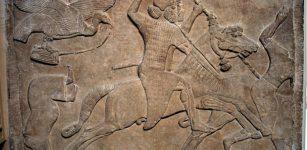 Invention Of Ancient Military Technologies Throughout World History Investigated
Archaeology | Oct 23, 2021
Invention Of Ancient Military Technologies Throughout World History Investigated
Archaeology | Oct 23, 2021 -
 Powerful Chola Rulers Of Southern India: Patrons Of Architecture, Art And Literature
Civilizations | May 4, 2017
Powerful Chola Rulers Of Southern India: Patrons Of Architecture, Art And Literature
Civilizations | May 4, 2017 -
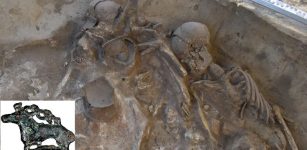 2,000-Year-Old Tumulus Of Unknown Culture Discovered In Siberia – Who Were These People?
Archaeology | Jan 4, 2023
2,000-Year-Old Tumulus Of Unknown Culture Discovered In Siberia – Who Were These People?
Archaeology | Jan 4, 2023 -
 12 Ancient Myths, Legends And Biblical Stories Confirmed By Modern Science
Featured Stories | Apr 22, 2017
12 Ancient Myths, Legends And Biblical Stories Confirmed By Modern Science
Featured Stories | Apr 22, 2017 -
 How Did Sea Level Rise Impact Human Groups During Mesolithic And Neolithic Periods?
Archaeology | May 20, 2022
How Did Sea Level Rise Impact Human Groups During Mesolithic And Neolithic Periods?
Archaeology | May 20, 2022

